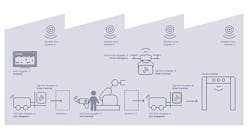If it's possible for COVID-19 to have any silver lining, it's likely jumpstarted many long-overdue efforts to evaluate and adopt digitalization technologies, such as Industrial Internet of Things (IIoT) device and cloud-computing services.
"Mobile devices like tablet PCs and smart phones can run software apps that let users set alerts for potential quality issues, increase overall equipment effectiveness (OEE), and check ahead for more proactive management," says Luke Durcan, director of the EcoStruxure IIoT program for North America at Schneider Electric. "As a result, we're seeing increasing investment and improvement by users employing Aveva software in water/wastewater and other utilities, which are facing increasingly stranded data and assets, and large footprints with fewer staff.
"Because of these forces, mobile devices and remote-access applications are transitioning from simply pulling in stranded data and workflows to proactively pushing data and insights back to production for better decisions. Where they previously checked boxes for some data, users can now get information with much more analytics, share that knowledge and use it for training. The little insights they can glean are the gold dust that can make entire production processes work better."
Durcan adds that mobile devices and the far-flung data they can reach and provide includes large amounts of precious domain expertise from veteran operators and engineers. Once accessed and available, their know-how can be redistributed via other mobile devices, and applied an even larger scales.
“In the past, devices that could deliver this kind of data were costly and proprietary. Now, these functions run on Apple iOS and Android, and they’re a lot easier and cheaper, so everyone can use them,” says Durcan. “In addition, combining these capabilities with MQTT publish-subscribe communications and low-code programming makes them easier for onsite users to integrate for themselves and their colleagues. For example, Aveva's software library can be used by plant personnel without bringing in a system integrator or other third-party. This is all about adaptability and software tools that let users figure out how solve their own problems and make their jobs easier. "
For instance, Ascend Performance Materials in Houston, Texas, recently established mobile operator rounds and created a "visual factory" for its Nylon 6,6 process for textiles by using Aveva's Intelligence and Workflow software and its IntelaTrac mobile operator rounds software. Ascend wanted to eliminate manual data input, visualize its processes and accurately record all their information because it wasn't tracking well enough to ensure production efficiency and product quality, and its four plants in the southeastern U.S. lacked process consistency.
“Previously, someone had to constantly monitor the data to make sure we were able to see the trigger points we wanted during the production process,” says H. Walt Woodfin, maintenance reliability, Ascend. “Before Aveva, our teams didn’t have the proper tools to manage our facilities.”
Aveva's Intelligence software turns large amounts of time series and transactional data from multiple sources into actionable metrics and KPIs. The metrics and context information are retained as one version in an open-information model, which is warehoused and used by enterprise business intelligence tools that let Ascend's managers make strategic sense of it. Meanwhile, Aveva's Workflow software digitalizes manual and automated processes, including people, equipment and/or systems; models, executes, analyzes and improves them; and institutionalizes work processes that manage normal, unscheduled or disruptive events.
“We found a great benefit by maintaining a core user group and consistency throughout our plants,” says Terry Unruh, PE, production and maintenance process leader at Ascend. “Our operators now immediately view key data generated during the manufacturing processes at each plant, which enables us to operate more efficiently.”
Finally, Ascend implemented IntelaTrac Mobile Operator Rounds workforce and decision support system with configurable software and rugged, mobile handhelds. IntelaTrac enables workflow, data collection and general task management for operations, maintenance, production tracking and compliance. It lets Ascend's field workers transmit data collected with the handhelds back to the automation system, so it can be viewed on control room displays or by engineers and managers with plant information portals.
“We found that the overall Aveva solution was the best match for our requirement of handheld technology scanners,” says S. Melissa Scheppele, CIO and vice president of IT at Ascend. “IntelaTrac brings our field operators into the automation loop by giving them a powerful tool to complete their jobs.”
Combining IntelaTrac's software, handhelds, monitoring devices, and radio frequency identification (RFID) tags or bar codes improved Ascend's decision support system for its mobile workers to manage plant assets. As a result, the company saved $500,000 in utilities and materials costs and more than $1 million in maintenance costs, and avoided potential plant shutdowns that would have cost $2 million.
Durcan adds that some of the most innovative users of remote-access solutions in the past couple of years are are batch operators in consumer packaged goods (CPG) companies, who are using Schneider Electric's Secure Connect Advisor (SCA) software to connect and remotely control their PLCs and other devices. "There are two parts to this, tactical/proactive and strategic, and they need to be mixed. For example, we can implement SCA in a day. However, if a user wants a centralized data repository, including MES, DCS, IoT and quality data, then they must have a strategic intent and plan," explains Durcan. "Fortunately, the tools to do it are now available for small manufacturing operations and their prices are OK, too.
"To develop a plan, users can employ the Industrial Internet Consortium's materials for assessing what an Internet of Things (IoT) system needs and how they can develop it. It takes long-term, strategic maturity to deal with these issues, including how to drive sustainability, decarbonize, and perform reactive energy management with better decisions on when to turndown or turn off processes."






